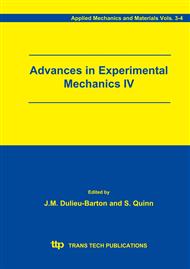p.155
p.161
p.167
p.173
p.179
p.185
p.191
p.197
p.205
Interlaminar Shear Strength and Fractographic Evaluation with Varying Temperature and Moisture Content of Thermoplastic Composites
Abstract:
This paper is related to the understanding of the relationship between the apparent interlaminar shear strength and the temperature-moisture content by the analysis of the dominant failure mode. It assesses the fracture mode of laminates with carbon fiber fabrics in (0, 90, 45)S ply orientation reinforced Polyphenylenesulphide (PPS) polymer matrix, tested for Interlaminar Shear Strength by the Short Beam method. Tests were conduced at different temperatures: (+20°C), (+0°C), and (-55°C), under various moisture-absorbed contents, namely Dry, 25%, 50%, and 75% of the saturated condition. Fractographic analyses were made and reveal, by the analysis of the fracture surface, the dominant mode of failure in every temperature-moisture content pair. As expected it is verified that temperature is a degradation factor. It is also found that humidity is not a degradation factor and, above the water freezing temperature, the moisture content even becomes a strengthening factor on this thermoplastic composite
Info:
Periodical:
Pages:
179-184
Citation:
Online since:
August 2006
Price:
Сopyright:
© 2005 Trans Tech Publications Ltd. All Rights Reserved
Share:
Citation:


